Checkpoint SSL VPN Integration
General Overview
This guide explains the configuration of multi-factor authentication (MFA) for Check Point appliance with Mirket. It also includes instructions to configure your Check Point appliance for integration with Mirket.
Prior configuration and deployment of Check Point appliance are required before setting up MFA with Mirket. Check Point appliance offers various MFA configuration modes. In this integration, we've configured RADIUS authentication with Mirket.
Create a new RADIUS server entity: Open the Check Point SmartConsole (available only on Windows OS). Go to the top-left menu and choose New Object > New Host.
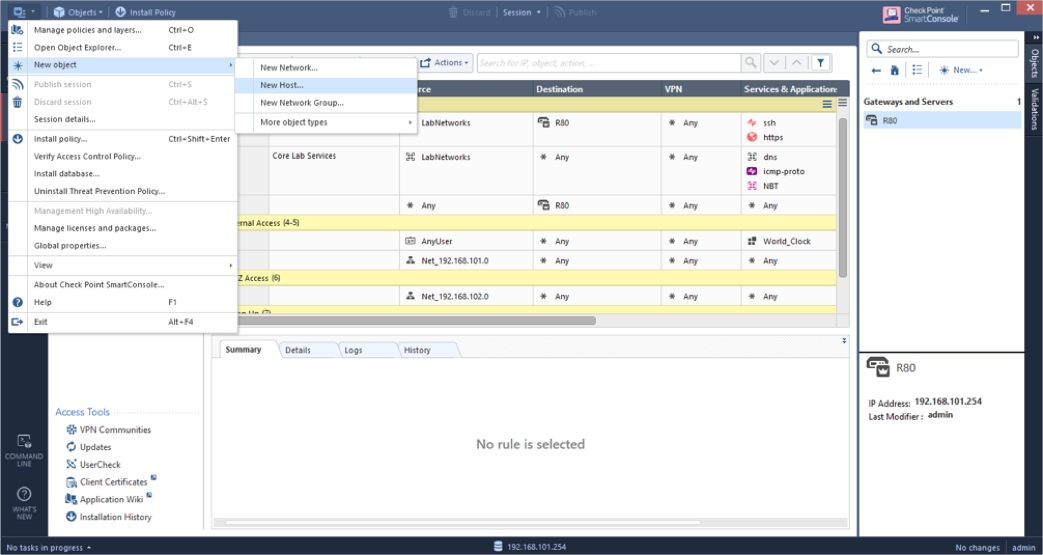
Input the following details:
Name: Provide a distinct name for the machine hosting the RADIUS server. For example: MyHost.
IPv4 Address: Enter a unique IP address assigned to the host running the RADIUS server. For example: 192.168.1.101.
Click OK to proceed.
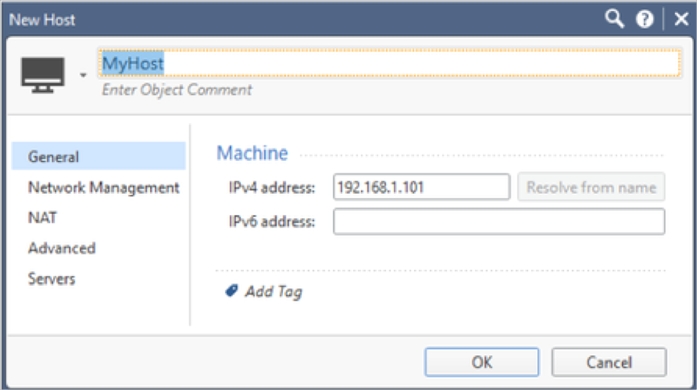
From the menu in the upper-left corner, go to New Object > More Object Types > Server > More > New RADIUS. Then, provide the following information:
Name: Assign a distinctive name for the RADIUS server. Example: MyRADIUS.
Host: Choose the Host object you created earlier.
Service: Set this to NEW-RADIUS to align with UDP port 1812, which was configured previously in the RADIUS application.
Shared Secret: Enter the RADIUS secret that you configured in the Mirket RADIUS setup.
Version: Choose RADIUS Ver 2.0.
Protocol: Select PAP.
Priority: Default is set to 1. You can adjust this if you're configuring multiple RADIUS servers.
Click OK to save.
Note: Ensure that the Check Point Management Server can reach the RADIUS server over UDP port 1812 (authentication) and UDP port 1813 (accounting). You may need to allow these ports through intermediate firewalls or network access control lists.
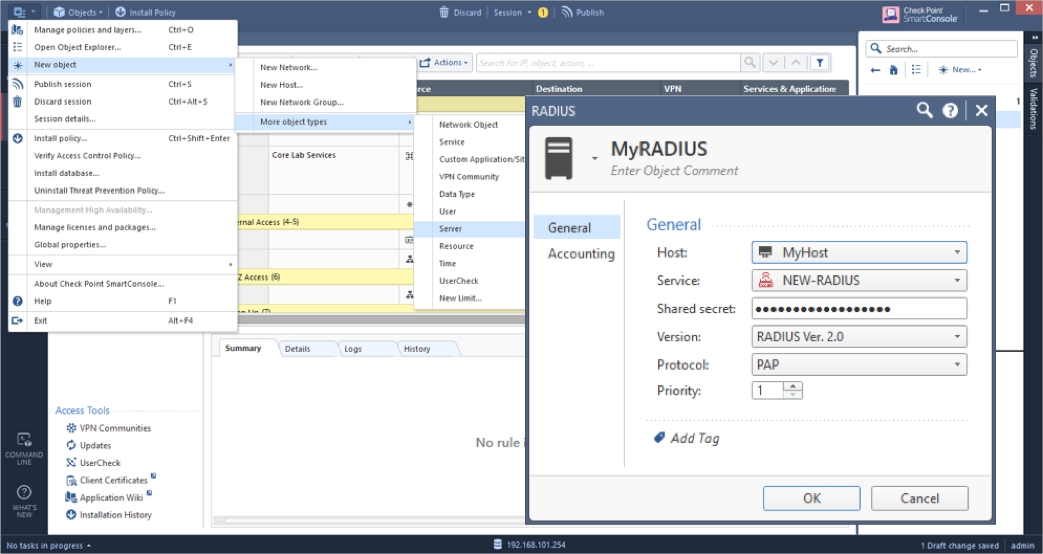
From the top-left menu, go to Global Properties > Advanced > SecuRemote/SecuClient. Enable the add_radius_groups option by checking the box, then click OK to apply the changes.
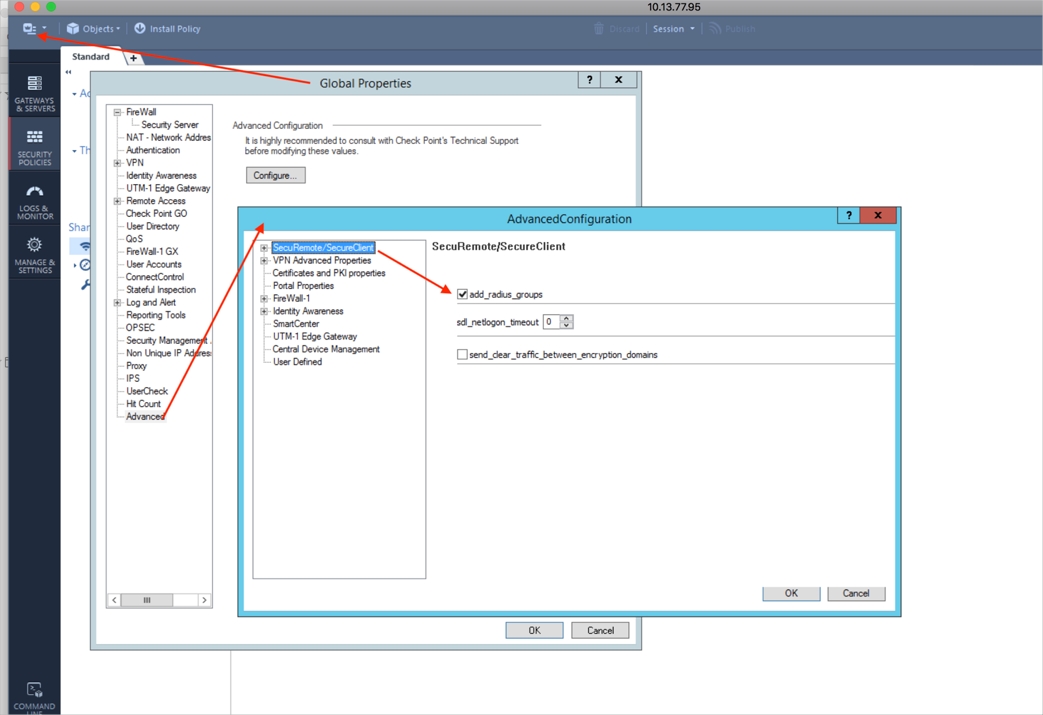
Create the RADIUS User Groups
Note: You only need to create RADIUS user groups if they will be used as Participant User Groups. Otherwise, this step can be skipped.
Open the top-left menu and navigate to: New Object > More Object Types > User > New User Group.
Enter a name for the group using the following format: RAD_<name of the group the RADIUS users belong to>.
Note: For older software versions, the naming format may vary. Consult your administration guide for specific requirements.
Ensure the group is empty. Click OK, then click Close.

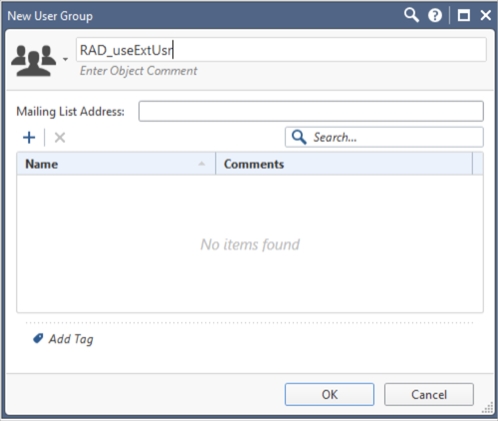
Note: Ensure that there is a firewall rule allowing SSL VPN access for members of this RADIUS user group. Without this rule, authenticated users in the group will not be able to establish VPN sessions successfully.
Go to VPN Clients > Authentication > Settings. In the Single Authentication Clients Settings window, choose RADIUS as the authentication method. For the Server option, select the RADIUS server you configured earlier. Once everything is set, click OK to save the changes.

Select Mobile Access in the Access Control policy. Click the link to open the Mobile Access Policy in SmartDashboard.
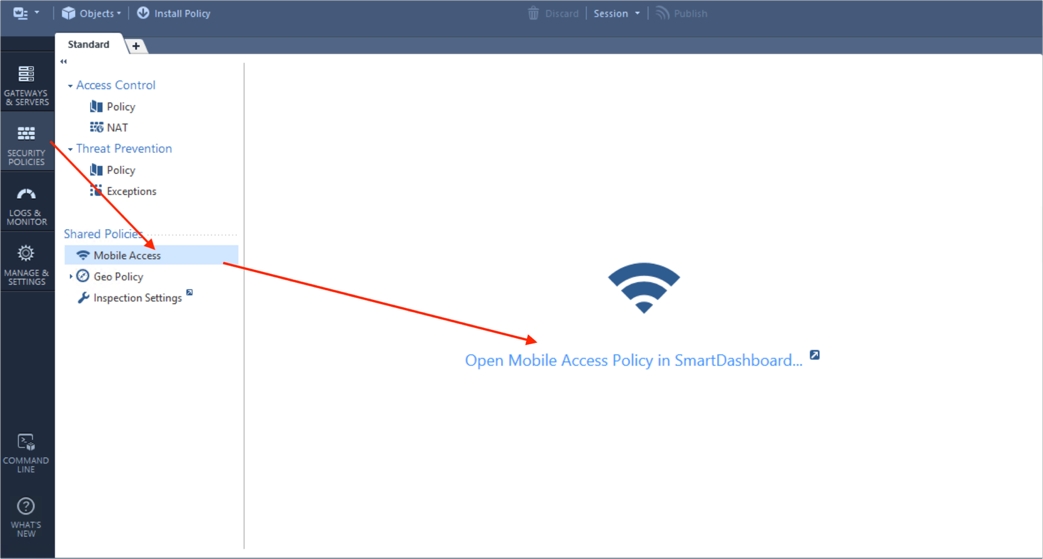
In the bottom-left corner, select the Users object. Right-click on External User Profiles, then go to New External User Profile > Match all users.

The following External User Profile Properties dialog opens:
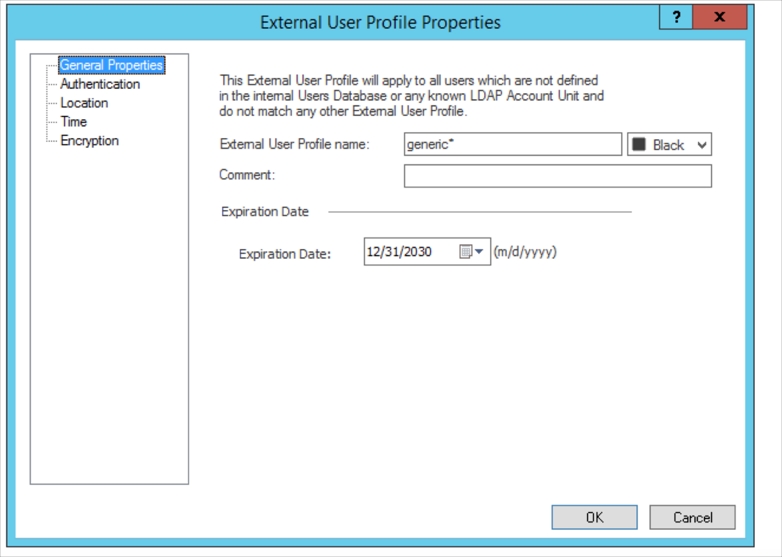
Go to the Authentication section and choose RADIUS as the authentication scheme. Then, select the previously configured RADIUS server—for example, RadiusServer-1. Once completed, click OK to confirm your settings.
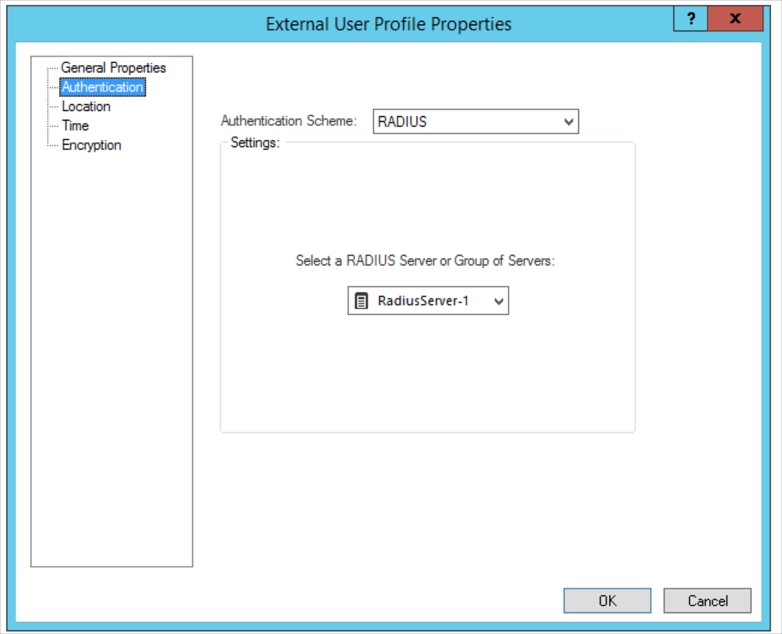
Click OK, then open the Menu and choose File > Update. After that, close SmartDashboard to return to the SmartConsole. To apply the changes, click Install Policy—this will publish your updates and deploy the policy to the R80 gateway.
Configure Mirket
To enable Mirket to receive authentication requests from Check Point, follow these steps:
Define Check Point appliance as a RADIUS client resource within Mirket.
Create an authentication policy for the Check Point RADIUS client resource or include it in an existing authentication policy.
Attach the Check Point resource to the Mirket Radius.
Add Check Point as a Resource in Mirket with Radius Gateway
Before starting, ensure that you have installed Mirket Radius Gateway from the Configuration > Gateway. To add a Radius Gateway to the Mirket, follow these steps:
Go to Configuration > Gateway and click on the Add Radius Gateway button.
On the displayed screen, enter a name for your Radius Gateway in the Name field.
Enter the SAM value of the gateway in the Sam Value field. In Mirket, user identification is done using the SAM (Security Account Manager) name. This is preferred over the standard username. This username is used for authentication and access controls.
Enter the IP address of the server where the gateway is installed in the Host IP Address field.
Enter the authentication port value you set for the gateway in the Auth Port field. The default value is 1812.
Enter the accounting port value you specified for the gateway in the Acc Port field. The default value is 1813. Note: After completing these fields, you must create a RADIUS client for the newly created RADIUS Gateway.
Click on the Add Radius Client option at the bottom of the displayed screen.
Enter a name for your Radius Client in the Radius Client field.
Enter the IP address of the client(firewall) that will communicate with the gateway in the IP Address field.
Enter the secret key that the client will communicate with the gateway in the Secret Key field.

Click on the Save button to confirm the settings.

Configuring Radius Gateway
After creating the Radius Gateway, click on the Download > Config from the menu on the right side of the gateway.

This option will generate a script related to the gateway, which will be displayed from the RADIUS Setup config file. The config file will automatically begin downloading once this option is selected.

Replace the existing config file in the
"C:\MirketRadius"directory with the downloaded file. Alternatively, copy the displayed script and paste it into the config file in"C:\MirketRadius".

Then, restart the Mirket Radius Service.

You can check whether the Radius Gateway you created is active by navigating to Configuration > Gateway.
User and Group configuration on Mirket
To set up multifactor authentication, make sure you have at least one user or group in Mirket.
If it is preferred to use a local user, you can first create a local group and then create a local user and make the user a member of the group. Alternatively, you can create a local user without creating a local group.
If it is preferred to use LDAP users, the priority External Source is created by pulling users from Active Directory or OpenLDAP in Mirket. Note: Before proceeding, ensure that you have installed Mirket LDAP Gateway. (Refer to create LDAP Gateway.)
Add a Radius Rule to Mirket
Radius Rules define user access to resources and the authentication methods available (such as SMS, Approve / Deny, OTP, etc.).
First, you should follow these steps:
Go to Configuration > Radius Rules.
Click on the Add Radius Rule button.
On the displayed screen, enter a name for the rule in the Name field.
Enter the rule description in the Description field.
Select the Radius Client to which the rule will apply from the Radius Client dropdown list.
Enter the source IP addresses to which the rule will apply in the Source Adress field.
Select the source countries where the rule will be applied from the Source Country dropdown list.
Click on the Next button.

Specify whether the rule will be applied to a user or a group.
After specifying, click on the Next button.

Select the users or groups to which the rule will apply. Transfer your selections to the Selected Users/Groups table by clicking the arrow icon next to the Available Users/Groups table.
Click on the Next button.


Select the time period when the rule will run.
All: The rule will run every day.
Recurring: The rule will run on the specified days and times.
One Time: The rule will run within the date range you specify.
After selecting, click on the Next button.

Specify whether the user or group will be granted access based on the rule in the Action field.
Select the authentication provider to which the rule will apply from the Auth Method dropdown list.

Click on Save to confirm the settings.

Test the Integration
To validate the integration between Mirket MFA and your Check Point appliance, perform authentication using a mobile token on your mobile device. For RADIUS resources, available authentication methods include Approve/Deny authentication.
In this example, we illustrate the use of the Approve/Deny authentication method.
Launch the Check Point Endpoint Security client application. Then click on the VPN client icon in the taskbar and select Connect to.
Choose the public IP address of the Check Point appliance from the Site dropdown list.
Enter your Mirket username in the Username field.
Input your password in the Password field.

Click on Connect. Then, select the 'Approve' option(found in the Mirket mobile app) immediately and make sure it doesn't time out.

Related Topics
Last updated